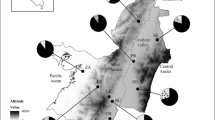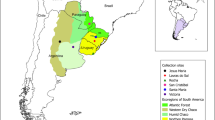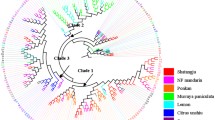Abstract
Cheyletus malaccensis is a predatory mite widely distributed in grain storages. It has been regarded as an important biological control agent for pest mites. In this study, we investigated the population genetic structure of C. malaccensis distributed in China based on the partial regions of mitochondrial COI and 12S rRNA genes. We collected 256 individuals of C. malaccensis from stored grain in 34 sites of China. We detected 50 COI gene haplotypes and nine 12S rRNA gene haplotypes. There were three clades in the haplotype network and Bayesian and maximum parsimony phylogenetic trees based on COI sequences, and two based on 12S rRNA sequences. The clustering of haplotypes was not correlated with their geographical distributions. The analysis of molecular variance, AMOVA, indicated that the genetic differentiation between populations was relatively weak. The major genetic differentiation was found within populations. We suggest that the genetic structure of C. malaccensis observed in this study may be the result of long-term climate fluctuations and recent human disturbances.


Similar content being viewed by others
References
Athanassiou CG, Palyvos NE, Eliopoulos PA, Papadoulis GT (2002) Mites associated with stored seed cotton and related products in Greece. Phytoparasitica 30:387–394
Bailly X, Migeon A, Navajas M (2004) Analysis of microsatellite variation in the spider mite pest Tetranychus turkestani (Acari: Tetranychidae) reveals population genetic structure and raises questions about related ecological factors. Biol J Linn Soc 82:69–78
Carbonnelle S, Hance T, Migeon A, Baret P, Cros-Arteil S, Navajas M (2007) Microsatellite markers reveal spatial genetic structure of Tetranychus urticae (Acari: Tetranychidae) populations along a latitudinal gradient in Europe. Exp Appl Acarol 41:225–241
Cebolla R, Pekár S, Hubert J (2009) Prey range of the predatory mite Cheyletus malaccensis (Acari: Cheyletidae) and its efficacy in the control of seven stored-product pests. Biol Control 50:1–6
Collins DA (2006) A review of alternatives to organophosphorus compounds for the control of storage mites. J Stored Prod Res 42(4):395–426
Demetras NJ, Hogg ID, Banks JC, Adams BJ (2010) Latitudinal distribution and mitochondrial DNA (COI) variability of Stereotydeus spp. (Acari: Prostigmata) in Victoria Land and the central Transantarctic Mountains. Antarct Sci 22:749–756
Excoffier L, Laval G, Schneider S (2005) Arlequin (version 3.0): an integrated software package for population genetics data analysis. Evol Bioinform 1:47
Folmer O, Black M, Hoeh W, Lutz R, Vrijenhoek R (1994) DNA primers for amplification of mitochondrial cytochrome c oxidase subunit I from diverse metazoan invertebrates. Mol Mar Biol Biotech 3(5):294–299
Hall TA (1999) BioEdit: a user-friendly biological sequence alignment editor and analysis program for Windows 95/98/NT. Nucl Acids Symp Ser 41:95–98
Hewitt GM (1996) Some genetic consequences of ice ages, and their role in divergence and speciation. Biol J Linn Soc 58(3):247–276
Hewitt GM (2000) The genetic legacy of the Quaternary ice ages. Nature 405(6789):907–913
Hubert J, Dolečková-Marešová L, Hýblová J, Kudlíková I, Stejskal V, Mareš M (2005) In vitro and in vivo inhibition of α-amylases of stored-product mite Acarus siro. Exp Appl Acarol 35:281–291
Hubert J, Hyblova J, Munzbergova Z, Pekar S, Křížkova-kudlíková I, Dolečková-marešová L, Stejskal V, Mares M (2007) Combined effect of an antifeedant α-amylase inhibitor and a predator Cheyletus malaccensis in controlling the stored-product mite Acarus siro. Physiol Entomol 32:41–49
Hubert J, Műnzbergová Z, Kučerová Z, Stejskal V (2006) Comparison of communities of stored product mites in grain mass and grain residues in the Czech Republic. Exp Appl Acarol 39:149–158
Jeyaprakash A, Hoy MA (2002) Mitochondrial 12S rRNA sequences used to design a molecular ladder assay to identify six commercially available phytoseiids (Acari: Phytoseiidae). Biol Control 25:136–142
Lee S, Peterson CJ, Coats JR (2003) Fumigation toxicity of monoterpenoids to several stored product insects. J Stored Prod Res 39:77–85
Li T, Zhang M, Qu YH, Ren ZM, Zhang JZ, Guo YP, Heong KL, Villareal B, Zhong Y, Ma EB (2011) Population genetic structure and phylogeographical pattern of rice grasshopper, Oxya hyla intricata, across Southeast Asia. Genetica 139:511–524
Librado P, Rozas J (2009) DnaSP v5: a software for comprehensive analysis of DNA polymorphism data. Bioinformatics 25(11):1451–1452
Miller MP (1997) Tools for population genetic analyses (TFPGA) 1.3: a Windows program for the analysis of allozyme and molecular population genetic data. Comput softw distrib author 4:157
Navajas M, Lagnel J, Gutierrez J, Boursot P (1998) Species-wide homogeneity of nuclear ribosomal ITS2 sequences in the spider mite Tetranychus urticae contrasts with extensive mitochondrial COI polymorphism. Heredity 80:742–752
Navajas M, Tsagkarakov A, Lagnel J, Perrot-Minnot M-J (2000) Genetic differentiation in Tetranychus urticae (Acari: Tetranychidae): polymorphism, host races or sibling species? Exp Appl Acarol 24:365–376
Nylander JAA (2004) MrModeltest v2. Program distributed by the author. Evolutionary Biology Centre, Uppsala University, Uppsala
Osakabe M, Goka K, Toda S, Shintaku T, Amano H (2005) Significance ofhabitat type for the genetic population structure of Panonychus citri (Acari: Tetranychidae). Exp Appl Acarol 36:25–40
Pekár S, Hubert J (2008) Assessing biological control of Acarus siro by Cheyletus malaccensis under laboratory conditions: effect of temperatures and prey density. J Stored Prod Res 44:335–340
Phillips TW, Throne JE (2009) Biorational approaches to managing stored-product insects. Annu Rev Entomol 55:375–397
Pimentel D (2009) Pesticides and pest control. In: Peshin R, Dhawan AK (eds) Integrated pest management: innovation-development process. Springer, Amsterdam, pp 83–87
Polzin T, Daneshmand SV (2003) On steiner trees and minimum spanning trees in hypergraphs. Oper Res Lett 31:12–20
Rajendran S, Sriranjini V (2008) Plant products as fumigants for stored-product insect control. J Stored Prod Res 44:126–135
Ronquist F, Huelsenbeck JP (2003) MrBayes 3: Bayesian phylogenetic inference under mixed models. Bioinformatics 19(12):1572–1574
Ros VID, Breeuwer JAJ (2007) Spider mite (Acari: Tetranychidae) mitochondrial COI phylogeny reviewed: host plant relationships, phylogeography, reproductive parasites and barcoding. Exp Appl Acarol 42:239–262
Schöller M, Prozell S, Al-Kirshi A-G, Reichmuth C (1997) Towards biological control as a major component of integrated pest management in stored product protection. J Stored Prod Res 33:81–97
Shen CP (1975) Preliminary notes on chinese cheyletida mites and the life history of Cheyletus malaccensis ouds. (Acarina: Cheyletidae). Acta Entomol Sin 3:316–323 (in Chinese)
Skoracka A, Dabert M (2010) The cereal rust mite Abacarus hystrix (Acari: Eriophyoidea) is a complex of species: evidence from mitochondrial and nuclear DNA sequences. B Entomol Res 100:263–272
Stejskal V, Hubert J, Kucerova Z, Munzbergova Z, Lukas J, Zd Arkova E (2003) The influence of the type of storage on pest infestation of stored grain in the Czech Republic. Plant Soil Environ 49:55–62
Sun JT, Lian C, Navajas M, Hong XY (2012) Microsatellites reveal a strong subdivision of genetic structure in Chinese populations of the mite Tetranychus urticae Koch (Acari: Tetranychidae). BMC Genet 13:8
Swofford DL (2003) PAUP*. Phylogenetic Analysis Using Parsimony (*and Other Methods) version 4. Sinauer Associates, Sunderland
Tamura K, Peterson D, Peterson N, Stecher G, Nei M, Kumar S (2011) MEGA5: molecular evolutionary genetics analysis using maximum likelihood, evolutionary distance, and maximum parsimony methods. Mol Biol Evol 28(10):2731–2739
Tsagkarakou A, Navajas M, Lagnel J, Pasteur N (1997) Population structure in the spider mite Tetranychus urticae (Acari: Tetranychidae) from Crete based on multiple allozymes. Heredity 78:84–92
Tsagkarakou A, Navajas M, Papaioannou-Souliotis P, Pasteur N (1998) Gene flow among Tetranychus urticae (Acari: Tetranychidae) populations in Greece. Mol Ecol 7:71–79
Wang B, Jiang J, Xie F, Li C (2013) Phylogeographic patterns of mtDNA variation revealed multiple glacial refugia for the frog species Feirana taihangnica Endemic to the Qinling Mountains. J Mol Evol 76:112–128
Xia B (2010) A review of progress on the systematics and biology of the family Cheyletidae in China, with a checklist of the Chinese cheyletids. Zoosymposia 4:158–164
Xie L, Hong XY, Xue XF (2006) Population genetic structure of the twospotted spider mite (Acari: Tetranychidae) from China. Ann Entomol Soc Am 99:959–965
Yang C, Li YX, Yang XM, Sun JT, Xu XN, Hong XY (2012) Genetic variation among natural populations of Euseius nicholsi (Acari: Phytoseiidae) from China detected using mitochondrial cox I and nuclear rDNA ITS sequences. Syst Appl Acarol 17:171–181
Yuan ML, Wei DD, Zhang K, Gao YZ, Liu YH, Wang BJ, Wang JJ (2010) Genetic diversity and population structure of Panonychus citri (Acari: Tetranychidae), in China based on mitochondrial COI gene sequences. J Econ Entomol 103:2204–2213
Zhang DX, Yan LN, Ji YJ, Hewitt GM, Huang ZS (2009) Unexpected relationships of substructured populations in Chinese Locusta migratoria. BMC Evol Biol 9:144
Acknowledgments
We are very grateful to Prof. Jun Rong for his thoughtful discussion, help with data analysis and improving the text of the manuscript. We thank two anonymous referees for their very helpful and constructive comments on the manuscript. We thank Ms. Fen Chen, Ms. Yuan Tian, Mr. Shuxian Song, Mr. Xiaoyong Fu, Mr. Denglu Yang, Mr. Zhaorong Peng, Ms. Shu Gong, Ms. Tianyi Sun and Dr. Shengquan Que for their help with specimen collection. We acknowledge Prof. Luzhang Ruan for the help with software usage, and Dr. Shu Li for the help with the making of the sampling map. This study has been supported by Grants from the Chinese National Natural Science Foundation (No. 31160418).
Author information
Authors and Affiliations
Corresponding author
Additional information
Xiaoqiang Yang and Qingtian Ye are the Co-first authors.
Electronic supplementary material
Below is the link to the electronic supplementary material.
Rights and permissions
About this article
Cite this article
Yang, X., Ye, Q., Xin, T. et al. Population genetic structure of Cheyletus malaccensis (Acari: Cheyletidae) in China based on mitochondrial COI and 12S rRNA genes. Exp Appl Acarol 69, 117–128 (2016). https://doi.org/10.1007/s10493-016-0028-3
Received:
Accepted:
Published:
Issue Date:
DOI: https://doi.org/10.1007/s10493-016-0028-3




